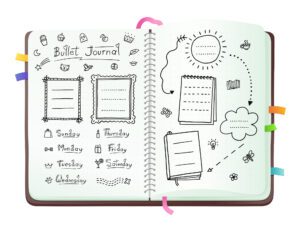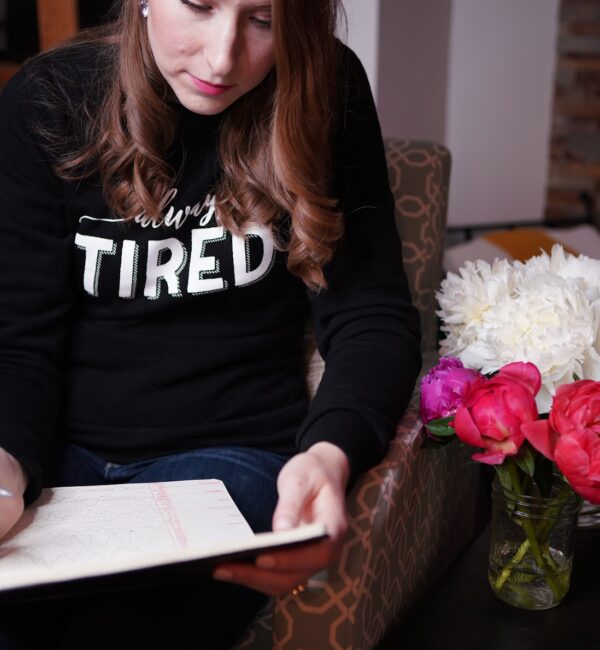You don’t have to tell 31-year-old Heather DeSandoli that journaling can turn your life around — she’s living proof.
“About six years ago, I was at a low point in my health journey,” says Heather, who has been living with fibromyalgia, chronic fatigue syndrome, and postural orthostatic tachycardia syndrome (POTS) since age 13. After pushing herself to complete her undergrad degree at Carleton University in Ottawa, Ontario, Canada, she decided to stay on at Carleton, embarking on a master’s program in political science.
Problem was, Heather felt utterly depleted. “I was doing poorly health-wise; I wasn’t talking about my health to my friends. I was trying to pretend I was fine, but I wasn’t.” And her symptoms — pain, fatigue, sleep issues, brain fog, and nausea — were out of control.
That’s when she turned to words. “It’s always been easier for me to write how I was feeling than to say it out loud,” says Heather, who decided to give “bullet journaling” (also called “bujo”) a try. Equal parts planner, health log, and diary, bujos help people stay on top of their To-Dos, track their goals, and get in touch with their feelings. And although there’s no one way to do it, most people start with a dotted grid notebook (Heather recommends the Leuchtturm 1917) and customize it as they see fit. This is different than a regular journal that has lined pages.


Credit: iStock/sabelskaya
For Heather, that meant creating something she called a “vitals graph,” where she plotted her hours of sleep, activity, and pain levels. She also added a symptom log, where she would tick off each one as it would happen. And perhaps most important, her daily page, where she would check in with how she was doing emotionally, physically, and spiritually.
Within one week, the journal transformed her life, says Heather.
“Seeing everything on paper — my pain, my energy, my sleep, my every day — I thought to myself, ‘Okay, this is real.’”
Snapped out of denial, Heather decided to make big changes. She left school and moved back home with her parents in Calgary, spending the next three years focusing on symptom management. “After a couple years, I was feeling better and was able to do more,” says Heather, who tapped her newfound energy to start Pretty Sick Designs, which, among other things, features T-shirts with slogans such as “always tired,” “the pain is real,” and “Unicorns aren’t real, but chronic illness is.”
The Health Benefits of Journaling
Inspired to start a journal of your own? No matter how you decide to tackle it (there are as many different approaches as there are people), know there are significant benefits.
For example, studies show journaling can help people with chronic pain better adapt to their condition, ease anxiety, and even strength their immune system.
When talking to her clients about journaling, Chippewa, Wisoncsin-based psychotherapist Shelley Ramsey DeJongh, LPC, CSAC, explains that it encourages a process called neuroplasticity — “the brain’s ability to modify, adapt, or create new neuropathways in response to new experiences.” In short, you can help rewire your brain to perceive things differently — and journaling is one way to do that.
“It’s a beautiful way for people with chronic illness to share their thoughts and feelings, helping to reduce the emotional and physical symptoms associated with their condition,” notes DeJongh, who focuses a large part of her practice on helping people living with chronic health challenges. “When my clients journal about their pain and reframe their fears and anxieties to create healthier thoughts, their mood improves. It helps change self-defeating patterns some may have unintentionally adopted as a coping mechanism.”
DeJongh helps clients figure out the journaling strategy that suits them best. “Some people want prompts and guidance and benefit from a pain, gratitude, or poetry journal, while creative types might benefit from an artistic journal,” she says.
There is no right or wrong way to get intrusive thoughts out of your head and into a journal. It’s a matter of just starting and spending time self-reflecting,” says DeJongh, who recommends dating your journal entries and including strengths for that day’s post so you can monitor your progress. For example, highlight something that’s going well for you that day or a goal that you came closer to meeting.
Making Journaling Easier When You Have Chronic Pain
Sold on the benefits of journaling — but wonder how to make it work when a painful day can make it hard to even hold a pen? We asked occupational therapist Karen Jacobs, EdD, OT, Clinical Professor and Associate Dean for Learning & Innovation at Boston University, for some insight.
As it turns out, the question isn’t just academic for Jacobs: She herself was recently diagnosed with osteoarthritis (OA) — “It’s just in my right pinky now” — and does a form of journaling herself, setting an intention each day, and posting about it on social media. Here are a few strategies that she suggests:
Opt for a big, thick, lightweight pen
“I personally like a built-up pen that has a wider diameter and a grip on it,” says Jacobs. This will require less grip pressure and less strain on your hand. “And choose a pen where the ink comes out easily, like a gel pen. It’s the most comfortable.”
Relax your grip
“Make sure you’re not putting a lot of force into holding your pen,” says Jacobs. “If you start to have tingling feelings, fatigue or pain, that means you’re exerting too much pressure.”
Start with just a few minutes of journaling per day and experiment with a few positions to see what’s most comfortable — whether sitting at your desk or writing sitting up in your bed.
Experiment with technique
When it comes to handwriting, some people find it easier to print; other, to use script. See what feels easiest and most natural to you.
Speak your truth
Jacobs recommends tapping the native voice-recognition software built into your smartphone. “You can set up a Google doc compatible with your software and dictate your journal right into your phone.” Try following the steps here.
Or try free audio journaling apps like Journify, Murmur, and Voice Diary.
Type it out
If keeping a journal on your computer is your preference, practice the following ergonomic strategies:
- Raise the computer so your monitor screen is just below eye height
- Position your computer monitor directly in front of you at an arms’ length away
- Place your arms and elbow close to your body, keep wrists straight and press keys lightly
If you are using an app on your smartphone, set the phone on your lap or a surface, use a stylus, and experiment with features like voice dictation, predictive text, and swipe typing to make it easier on your joints. Get more tips on how to text and type with less pain when you have arthritis.
Take breaks
Jacobs says it’s the most important thing people should be doing to avoid discomfort, pain, and fatigue, no matter your journaling style. “That means getting up. Stretching. Getting hydrated. Opening the window. Going outside.” She recommends a break every 30 minutes.
Tap high-energy periods
As someone with a chronic illness like arthritis or other challenges, you know your own body and your most energetic periods, says Jacobs.
“Your best time can change every day, so check in with yourself,” she says. If you have a lot of pain, opt for voice dictation over journaling by hand.
Experiment with different types of journaling
Experiment to find the type of journaling that works best for you and your pain levels. For example, bullet journaling may mean less writing than stream-of-consciousness journaling or gratitude journaling. Similarly, a journal with a prompt might help you focus your thoughts and write less.
Get Mental Health Support
We understand how difficult it can be to cope during these uncertain times, especially when you are living with chronic illness. It is important to talk to someone who can help. You should contact your primary care physician or your insurance provider to learn about the supportive resources that are available to you. Here are other mental health resources for your reference:
- To find local support groups and services, you can call 1-800-950-NAMI (6264) or email info@nami.org. The National Alliance on Mental Illness HelpLine can be reached Monday through Friday, 10 AM to 6 PM ET.
- For a counselor or therapist in your area, view the resources page at Mental Health America: Finding Therapy.
- If your mental health concern is an emergency for you or someone else, call 911.
- If you are having suicidal thoughts or have or are thinking of hurting yourself, you should call the National Suicide Prevention Lifeline’s 24-hour toll-free crisis hotline, 1-800-273-TALK (8255).
Furnes B, et al. Therapeutic writing and chronic pain: experiences of therapeutic writing in a cognitive behavioural programme for people with chronic pain: Experiences of therapeutic writing. Journal of Clinical Nursing. October 2012. doi: https://doi.org/10.1111/j.1365-2702.2012.04268.x.
Murray B. Writing to Heal. American Psychology Association. https://www.apa.org/monitor/jun02/writing.
Smyth JM, et al. Online positive affect journaling in the improvement of mental distress and well-being in general medical patients with elevated anxiety symptoms: a preliminary randomized controlled trial. JMIR Mental Health. December 2018. doi: https://doi.org/10.2196/11290.






